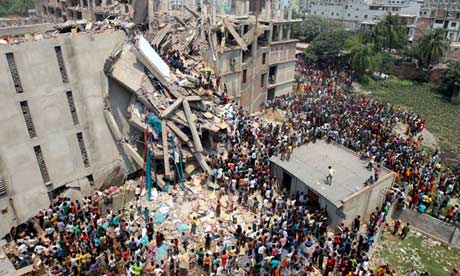The recent tragedy in
Bangladesh, where a collapsed building left behind 1000 people dead, has oulined that our cheap
clothing is at the expense of human rights.
Thousands of people were
working at several factories in a building without sufficient security measures
and poorly preserved. The conditions for the workers were extremely precarious.
All this would have
been overlooked if the Rana Plaza had not collapsed. But the magnitude of the
tragedy (1000 dead and counting) and the massive demonstrations on May Day in Bangladesh, have made it
impossible to ignore the fact any longer.
Big retail names like
Zara, H&M, Benetton and Wal Mart have been involved. As happened with Apple
and its factories in China, fashion giants outsource to other companies in Asia
to make the clothes that they then sell across the world.
It is one of the effects
of globalization. Today, it is cheaper to send raw materials and finished products to
go around the world several times than to make them in factories in Europe or
America.
Competition is also
fierce. A few years ago China was the main recipient of these contracts. But
since the standard of living of the Chinese has increased, their wage demands
have risen in line with it. Chinese wages are growing around 10% per year and this increase means lower
profit margins for textile giants.
That's where, since
the beginning of the credit crunch crisis, other countries like Bangladesh have
entered in the race. Without as many legal obstacles and with wages of around a dollar a day, these countries are a much more
appealing destination for large retail companies.
The way of doing
things, however, does not change. They hire contractors and subcontractors.
Sometimes the subcontractors hire even more subcontractors. In fact New Wave
Style, one of the companies involved in the Rana Plaza disaster, got its first
big contract when a contractor for the Canadian company Loblaws could not cope
with an order and appealed to them. From there, everything grew until
disaster struck.
The chain of
contractors and subcontractors is dark. And the more you go down the chain, the
less control you have over what happens.
Companies such as Primark claim to have under control the companies they hire.
But the truth is that it is impossible to be aware of the whole process when it
is so complex and confusing.
The conditions are
extremely precarious for the workers. Overtime is common to be able to meet
deadlines, but it is rarely paid. The workplaces are often poorly conditioned. Too
much heat, little ventilation and buildings without sufficient security
measures are the norm.
The unions tried to
improve those conditions imposing independently controlled safety plans, but the big brands rejected the plan. They needed a plan outside of the
corruption circle between factory owners and the government. But it was too
expensive and complex and retail companies said no.
It is not the first
time a disaster strikes the industry. In fact fashion giants have a long
history full of stains. From the use of child labor for sports brands manufacturers
to the recent fire in another factory (also in
Bangladesh), scandals are many.
That’s why crisis
management teams in brands like Loblaws and Primark have been so quick to
tackle the tragedy. Immediately, they announced that they will compensate the victims. Others like Benetton
have reacted slower. Even the EU has jumped into the wagon.
Zara in turn, has
increased its positive presence in various media, with stories that illustrate,
for example, how it employs young people in Spain, a country battered by
youth unemployment.
The general trend of
the industry has been a PR offensive. Big brands know that their main
battle is being fought in the streets of Paris, London or New York, with the public
opinion at home. After all, they are also to blame in part for wanting cheap clothes.
They are the ones who buy the clothes and they are the ones they need to
convince to bury all this in the past –until the next tragedy.
Governments and
workers in Bangladesh, on the other hand, are too afraid they may lose all they got. The wages of workers in these
factories, despite being extremely low, are sometimes the best that can be dreamed
of in these countries.
Meanwhile, export
remittances provide a generous source of revenue to governments. So much so,
that the government of Bangladesh has asked the EU not to impose
sanctions or
regulations on his country. They fear that, like it happened in China, the
factories will relocate to a less problematic country.
However, Bangladesh
would probably be better off looking towards Vietnam. The communist country has shown that it is
possible to get the production for multinational brands and improve the living
conditions of workers all at the same time. But that demands change and courage
to do it.
And probably as well,
less profit margins and more expensive clothes. But not much. With as little as a 25cents increase in the price of our clothes, we could pay for better working conditions in Bangladesh. Will it happen?


 5/13/2013
5/13/2013
 Ehiztari
Ehiztari



 Twitter
Twitter Facebook
Facebook Flickr
Flickr



0 comentarios:
Post a Comment